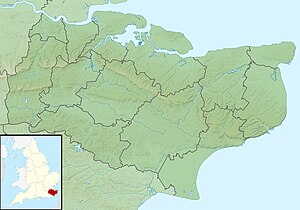Westerham Heights
| Betsom's Hill | |
|---|---|

View of Betsom's Hill from the south-west
|
|
| Highest point | |
| Elevation | 251 m (823 ft) |
| Listing | County Top |
| Coordinates | 51°17′18″N 0°03′26″E / 51.2882°N 0.057188°ECoordinates: 51°17′18″N 0°03′26″E / 51.2882°N 0.057188°E |
| Geography | |
|
Betsom's Hill in Kent
|
|
| Location | Westerham, England |
| OS grid | TQ 4355 5633 |
Betsom's Hill is a hill on the North Downs, and the highest point in the county of Kent at 251 metres (823 ft). Situated between Westerham and Tatsfield, at the western edge of the county, it lies close to where the A233 crosses the Downs en route to Biggin Hill. This is the highest part of the North Downs, with Botley Hill the highest point, nearby to the west. The hill lies at the western end of the Kent Downs, an area of outstanding natural beauty.
The crest of the hill was the location of a Victorian defence fort, one of twelve locations along the North Downs built to protect London in case of attack by foreign invaders crossing the channel. Known as Betsom’s Hill Fort or Westerham Fort, it was part of the London Defence scheme, and was intended to act both as a mobilisation centre for volunteer troops, and as an ammunition store. The fort which consisted of ramparts, casemates and a magazine has been partially demolished and converted for use as workshops, with private houses appropriately named Fort Cottages now occupying the site.
The highest part of the hill is unmarked, in an area inaccessible to the public, making it the only county top that is on private land and which cannot be easily visited. The lower slopes are more accessible, with the North Downs Way, a long distance trail passing beneath the crest, in an area known as Hill Park. Running in parallel at the foot of the scarp slope is another more ancient route, the Pilgrims Way.
The artist and craftsman, John Paul Cooper selected Betsom’s Hill as the location for his house, workshop and studio. He designed the house in the Arts and Crafts style to reflect the local Kentish architecture, and lived there until his death in 1933.
...
Wikipedia

